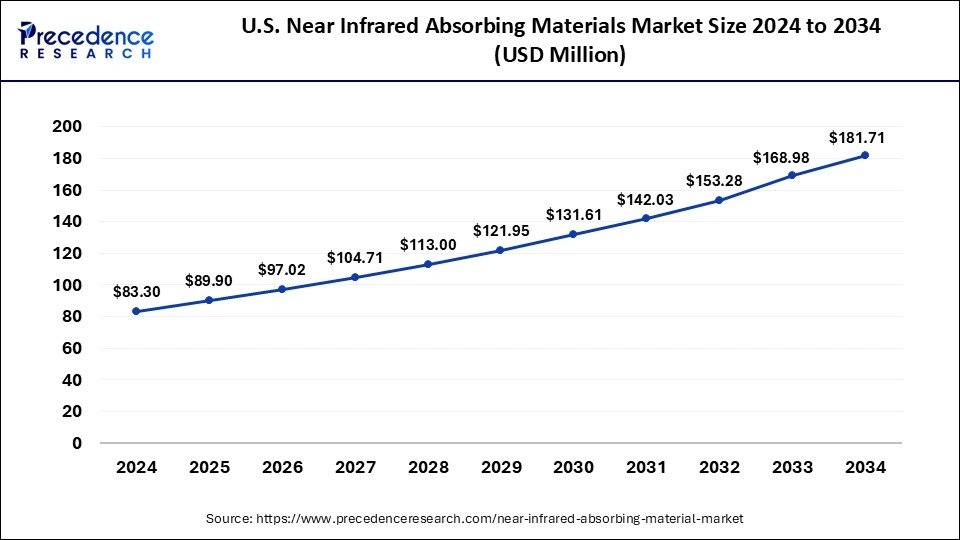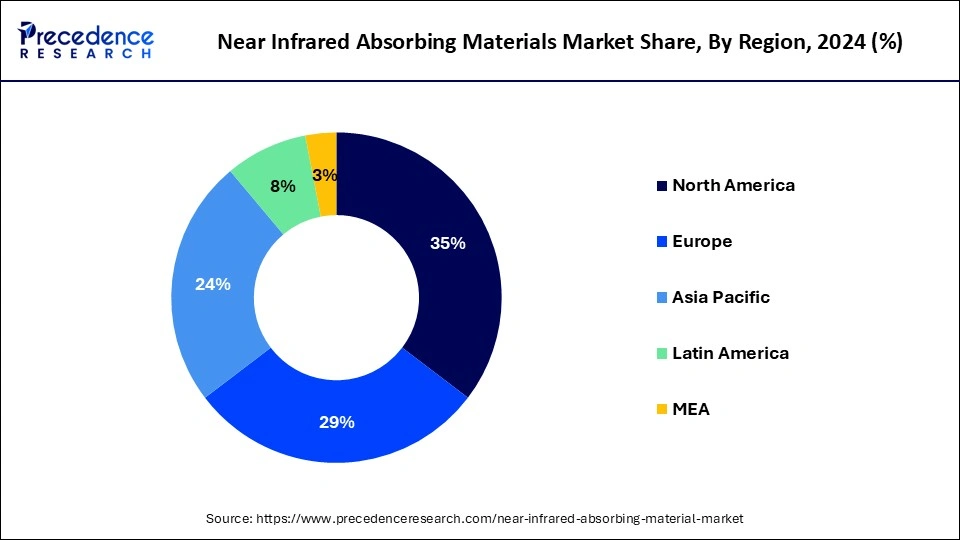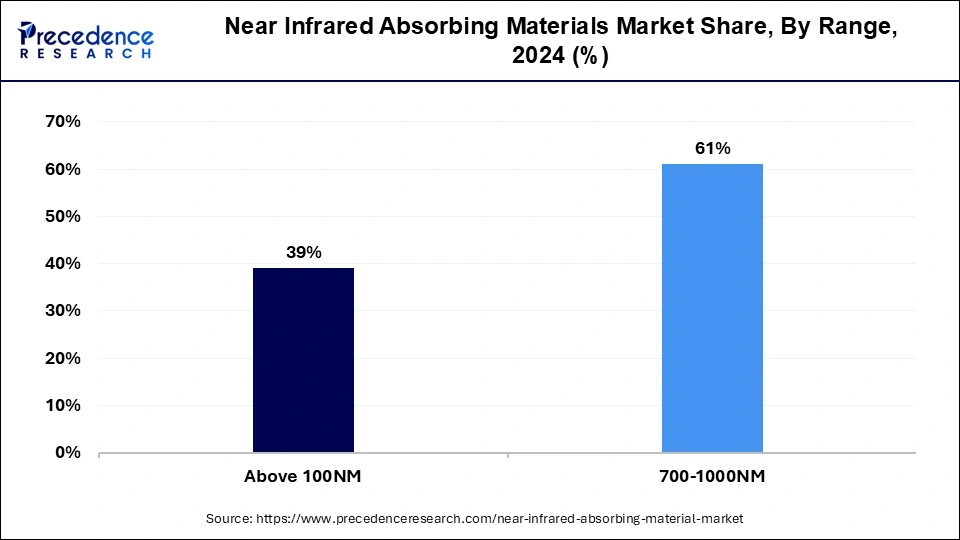Near Infrared Absorbing Materials Market Size and Growth 2025 to 2034
The global near infrared absorbing materials market size was estimated at USD 340.02 million in 2024 and is predicted to increase from USD 366.95 million in 2025 to approximately USD 722.31 million by 2034, expanding at a CAGR of 7.83% from 2025 to 2034. In applications such as solar energy harvesting and energy-efficient building materials, near infrared (NIR) absorption materials play a critical role. The need for the near infrared absorbing materials market is being driven by the increasing focus on energy-efficient and sustainable solutions.

Near Infrared Absorbing Materials Market Key Takeaways
- The global near infrared absorbing materials market was valued at USD 340.02 million in 2024.
- It is projected to reach USD 722.31 million by 2034.
- The near infrared absorbing materials market is expected to grow at a CAGR of 7.83% from 2025 to 2034.
- North America dominated the global market with the largest market share of 35% in 2024.
- By region, Asia Pacific is expected to host the fastest-growing market during the forecast period.
- By material, the organic segment held the largest share of the market in 2024.
- By material, the inorganic segment is expected to grow at the highest CAGR in the market during the forecast period.
- By range, the 700-1000 NM segment led the market with the largest share in 2024.
- By function, the absorption segment led the market in 2024.
- By application, the solar cells and photovoltaics segment led the market with the largest share in 2024.
- By end-use, the healthcare and medical segment dominated the market in 2024.
U.S. Near Infrared Absorbing Material Market Size and Growth 2025 to 2034
The U.S. near infrared absorbing material market size was exhibited at USD 83.30 million in 2024 and is projected to be worth around USD 181.71 million by 2034, poised to grow at a CAGR of 8.11% from 2025 to 2034.

North America held the largest share in the near infrared absorbing materials market in 2024. The market is expanding rapidly in North America due to a variety of uses in a wide range of sectors, such as defense, electronics, telecommunications, and automobiles. The electronics and telecommunications industry uses the most NIR-absorbing materials. These components are essential for creating optical filters and sensors, which improve the functionality and effectiveness of electronic equipment and communications networks.
The two main types of materials are organic and inorganic, with the latter more common because of superior qualities such as increased light absorption and thermal stability. The market for NIR absorbing materials in North America is expected to increase significantly due to a variety of applications in various sectors and continuous innovation by major players in the industry.

Asia Pacific is expected to be the fastest-growing in the near infrared absorbing materials market during the forecast period. The region's near infrared absorbing materials market is expanding rapidly due to rising demand in a number of sectors, including electronics, telecommunications, and industrial applications. It is anticipated that the Asia Pacific market for NIR absorbing materials will expand significantly, with South Korea and Japan playing a significant role.
As more research and development are being done to improve the qualities of NIR-absorbing materials, the market is expected to rise. Improvements in light absorption, thermal stability, and durability are anticipated as a result of developments in nanoparticles and nanocomposites. In the near infrared absorbing materials market, South Korea holds a prominent position, particularly in the semiconductor and electronics sectors, where these materials are utilized for flaw detection and inspection.
Market Overview
The growing need for cutting-edge technologies across a range of industries, including electronics, security, automotive, and healthcare, is propelling the near infrared absorbing materials market, a specialized but growing important area of the larger materials industry. Specialized materials called near-infrared absorbers are made to both absorb and use the near-infrared portion of the electromagnetic spectrum.
For applications requiring optical filtering, thermal control, and light absorption beyond the visible spectrum, these materials are essential. The need for the near infrared absorbing materials market is growing as electronics and optical devices continue to evolve, increasing the usefulness and efficiency of these devices. The usage of NIR absorption materials in night vision equipment and other surveillance technologies is driven by the increasing need for sophisticated security systems.
Non-invasive procedures and sophisticated imaging techniques are made possible by the near infrared absorbing materials market products, which are essential in medical imaging and diagnostic equipment. The need for these materials is fueled by the growing integration of in-cabin sensing technologies and advanced driver assistance systems (ADAS) in contemporary automobiles.
Innovation and implementation of the near infrared absorbing materials market in green building technologies and smart windows are driven by the growing emphasis on sustainable and energy-efficient solutions. The market is growing because of rising investments in healthcare technologies, especially in non-invasive imaging and diagnostic equipment.
Near Infrared Absorbing Materials Market Growth Factors
- The near infrared absorbing materials market is in high demand due to the growing use of touchscreens and displays in gadgets such as laptops, tablets, and smartphones. These components are essential for improving these devices' longevity and performance.
- LIDAR devices, which are essential to ADAS, use materials that absorb near-infrared light. These materials are in more demand as the car industry transitions to autonomous driving.
- Several medical imaging modalities use the near infrared absorbing materials market services because they offer improved tissue penetration and reduced tissue damage. Additionally, they are employed in therapeutic treatments such as photothermal therapy, where exact regulation of light absorption is essential.
- By boosting sensitivity and clarity in low light, NIR-absorbing materials improve the functionality of security cameras and night vision equipment. These components are used in security coatings and inks to stop money, documents, and branded goods from being counterfeited.
- NIR spectroscopy, which uses NIR-absorbing materials, is utilized for quality control and monitoring in sectors such as manufacturing and food processing. They are also employed in applications involving environmental sensing to identify and track contaminants.
- NIR absorbing materials are becoming more effective and adaptable due to ongoing material science research and development, which is broadening the range of applications for these materials. New applications and growth prospects are being driven by the integration of NIR-absorbing materials with emerging technologies such as the Internet of Things (IoT) and Artificial Intelligence (AI).
Market Scope
| Report Coverage | Details |
| Market Size by 2034 | USD 722.31 Million |
| Market Size in 2025 | USD 366.95 Million |
| Market Growth Rate from 2025 to 2034 | CAGR of 7.83% |
| Largest Market | North America |
| Base Year | 2024 |
| Forecast Period | 2025 to 2034 |
| Segments Covered | Material, Range, Function, Application, End-Use, and Regions |
| Regions Covered | North America, Europe, Asia-Pacific, Latin America, and Middle East & Africa |
Market Dynamics
Driver
Healthcare and medical applications
The near infrared absorbing materials market in healthcare and medical applications is a new and quickly developing industry. Because of their special qualities, materials that absorb near-infrared light are very helpful in a variety of medical and healthcare applications. Imaging approaches employ materials that absorb near-infrared radiation to provide high-contrast images of tissues. This method is useful for precise tumor removal during surgeries, especially those related to cancer, as it preserves good tissue. Biosensors that identify biomarkers in biological samples are equipped with materials that absorb near-infrared radiation. These sensors have the ability to identify diseases quickly and accurately.
Restraint
Competition from alternative technologies
NIR light can be absorbed and emitted by quantum dots, which are utilized in solar cells, displays, and medical imaging, among other applications. OPVs are less expensive to produce, lightweight, and flexible than conventional silicon-based NIR absorption materials. Applications to sensors and solar energy are being investigated. Because they are lightweight and flexible, materials like OPVs and certain nanomaterials are well-suited for wearable technology and flexible electronics. Collaborations among universities, research centers, and business enterprises are accelerating innovation and the commercialization of new innovations. The development of next-generation solar cells with higher efficiency and lower prices depends on advancements in the near infrared absorbing materials market.
Opportunity
Research and development
The near infrared absorbing materials market has different uses in many different industries. Near-infrared light, which falls between visible light and infrared radiation on the electromagnetic spectrum, can be absorbed or reflected by materials made specifically for this purpose. The market for NIR absorbing materials is anticipated to expand as new uses for current technology are found and advancements are made. The goals of research and development will probably be to increase application areas, lower prices, and improve performance. For this field to advance, cooperation between government, business, and academic institutions is essential.
Material Insights
The organic segment dominated the near infrared absorbing materials market in 2024. Conjugated polymers, tiny organic compounds, and dyes are the usual building blocks of organic NIR absorption materials. Phthalocyanines, squaraines, cocaine dyes, and cyanine dyes are examples of common varieties. Chemical alteration of organic materials can be used to fine-tune their absorption properties. Solutions can be used to treat a wide range of organic materials, making low-cost production methods like roll-to-roll processing and inkjet printing possible.
NIR-absorbing materials are used in organic photovoltaics (OPVs) to increase light absorption and solar cell efficiency, especially in tandem and multi-junction systems. Organic photodetectors (OPDs) and other optoelectronic devices employ organic NIR absorbers. The need for organic photovoltaics is being driven by the growing emphasis on sustainable energy solutions. New developments in NIR-absorbing materials are essential to the development of both economical and effective OPVs.
The inorganic segment is expected to grow at a significant rate in the near infrared absorbing materials market during the forecast period. Various compounds and nanoparticles that have the ability to absorb near-infrared light are included in the inorganic section of the market for NIR-absorbing materials. Because of these materials' special qualities such as stability, high absorption efficiency, and durability they are used in a variety of applications.
Used in automobile glass and smart windows to lower heat accumulation and increase energy efficiency. In greenhouses, NIR-absorbing materials aid in regulating the temperature and lighting. Innovations in NIR absorbing materials are being driven by ongoing research and development in material science and nanotechnology. Advances in NIR absorbing materials are becoming more and more necessary as industries like healthcare, electronics, and renewable energy grow.
Range Insights
The 700-1000 NM segment led the near infrared absorbing materials market in 2024. The 700-1000 nm range is optimal for a variety of applications, including medical imaging, optical sensing, and communication technologies.

This wavelength range provides a balance between deep tissue penetration and minimal absorption by water and other biological tissues, making it ideal for medical and biological applications.
Function Insights
The absorption segment dominated the global near infrared absorbing materials market in 2024. Light in the near-infrared range (700 nm to 2500 nm) is absorbed by these materials. They are employed to either block or convert near-infrared radiation into heat or electrical energy. Examples include rare-earth compounds, metal complexes, and nanoparticles, which are prized for their robust absorption properties and stability.
For anti-counterfeiting purposes, banknotes, passports, and other documents are printed with NIR-absorbing inks and dyes. In order to build sensors for industrial applications, environmental monitoring, and medical diagnostics, NIR-absorbing materials are essential. Materials used in thermal camouflage and smart windows that capture near-infrared radiation and transform it into heat. Improvements in material science have led to lower costs and better performance for NIR-absorbing materials.
The high transparency segment is expected to grow rapidly in the near infrared absorbing materials market during the forecast period. The near-infrared (NIR) absorbing materials market has a specialized but quickly expanding high transparency segment, driven by growing demand from a variety of industries and technological improvements. The electromagnetic spectrum's NIR light, which spans from around 700 nm to 2500 nm, is what these materials are intended to absorb. They are frequently employed in applications where it is necessary to selectively block NIR light while preserving visible spectrum transparency. Used in car sunroofs and windows to keep the view unobstructed while lowering interior heat buildup. Used in surveillance systems and security cameras to improve performance and image quality under different lighting circumstances.
Application Insights
The solar cells and photovoltaics segment held the largest share of the near infrared absorbing materials market in 2024. The global push towards renewable energy sources has increased investments in solar power. As a result, the demand for advanced materials that can improve the efficiency and performance of solar cells has surged, driving the growth of the NIR absorbing materials market in this segment. Utilizing NIR absorbing materials in solar cells contributes to the reduction of greenhouse gas emissions and reliance on fossil fuels. This environmental benefit aligns with global sustainability goals, further boosting the adoption of these materials in the photovoltaic industry.
End use Insights
The healthcare and medical segment dominated the near infrared absorbing materials market in 2024. The rising demand for medical imaging across the sector has boosted the growth of the segment. NIR absorbing materials are crucial in advanced medical imaging technologies, such as optical coherence tomography (OCT) and near-infrared spectroscopy (NIRS). These technologies are widely used for non-invasive diagnostics and monitoring, particularly in fields like ophthalmology, neurology, and cardiovascular medicine.
The electronics & telecommunication segment is observed to grow at the fastest rate during the forecast period in the near infrared absorbing materials market. In photodetectors used for sensing and communication applications, especially in fiber optics and wireless communication systems, NIR-absorbing materials are crucial. The performance and efficiency of light-emitting diodes (LEDs) and organic LEDs (OLEDs), which are extensively used in displays and lighting, are enhanced by NIR-absorbing materials. These materials aid in the separation of various wavelengths in WDM systems, which is essential for boosting telecommunication networks' capacity. For improved image and sensing capabilities, which are essential for security, surveillance, and remote sensing applications, NIR-absorbing materials are utilized in cameras and sensors. NIR-absorbing materials are used in a number of smartphone and tablet components to control heat, increase sensor performance, and improve display quality.
The industrial segment is projected to register a notable rate of growth in the near infrared absorbing materials market during the forecast period 2024 to 2033. Within the near-infrared absorbing materials market, the industrial sector category includes a variety of sectors and applications. Because of their capacity to absorb near-infrared radiation, NIR-absorbing materials are essential for a wide range of industrial applications.
This allows for the provision of advantages, including heat management, increased efficiency, and increased safety. In order to safeguard delicate components and increase operational effectiveness, heat management and reduction techniques in industrial processes employ NIR-absorbing materials. In order to improve passenger comfort and lessen the strain on air conditioning systems, NIR absorption materials are utilized in car coatings, films, and glass.
Near Infrared Absorbing Materials Market Companies

- Nanophase Technologies Corporation
- Heraeus Holding
- Keeling & Walker
- Edmund Optics
- Merck
- 3M
- Resonac Holdings Corporation
- Advanced Nano Products Co. Ltd.
- Nippon Shokubai Co. Ltd.
Recent Devlopment
- In October 2024, the research team of Professor Jung-Yong Lee of the School of Electrical Engineering at KAIST and Professor Woojae Kim of the Department of Chemistry at Yonsei University developed a high-efficiency and high-stability organic-inorganic hybrid solar cell production technology that maximizes near-infrared light capture beyond the existing visible light range.
- In March 2024, Sumitomo Metal Mining developed Solament, a unique material that absorb NIR from sunlight, generating heat within the material itself.
Segment Covered in the Report
By Material
- Organic
- Inorganic
By Range
- 700-1000nm
- Above 1000nm
By Function
- High Transparency
- Heat Resistance
- Solubility
- Absorption
- Others
By Application
- Solar Cells and Photovoltaics
- Optical Filters and Coatings
- Sensors and Detectors
- Anti-reflective Coatings
- Medical Imaging and Diagnostics
- Security and Surveillance
- Others
By End-Use
- Electronics and Semiconductor
- Energy and Solar
- Healthcare and Medical
- Aerospace and Defense
- Automotive
- Consumer Goods
- Building and Construction
- Others
By Geography
- North America
- Asia Pacific
- Europe
- Latin America
- Middle East & Africa
For inquiries regarding discounts, bulk purchases, or customization requests, please contact us at sales@precedenceresearch.com
Frequently Asked Questions
Ask For Sample
No cookie-cutter, only authentic analysis – take the 1st step to become a Precedence Research client
 sales@precedenceresearch.com
sales@precedenceresearch.com
 +1 804-441-9344
+1 804-441-9344